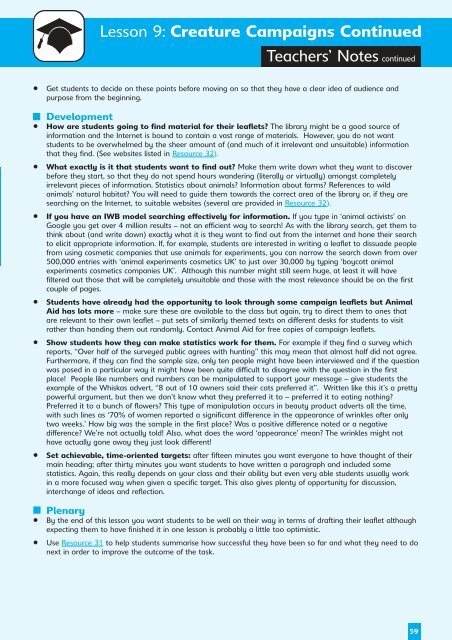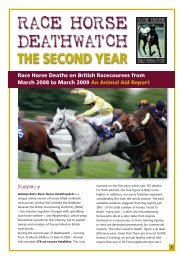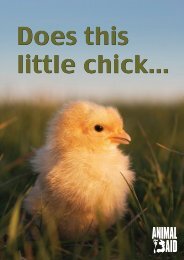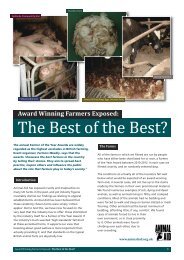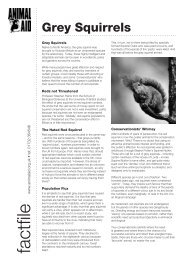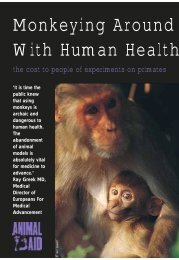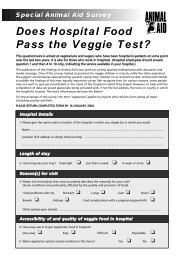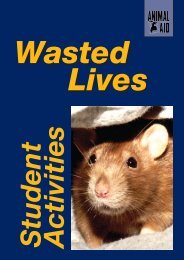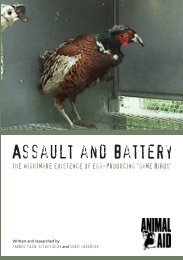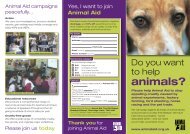English Resource Booklet 2 - Animal Aid
English Resource Booklet 2 - Animal Aid
English Resource Booklet 2 - Animal Aid
You also want an ePaper? Increase the reach of your titles
YUMPU automatically turns print PDFs into web optimized ePapers that Google loves.
Lesson 9: Creature Campaigns ContinuedTeachers’ Notescontinued• Get students to decide on these points before moving on so that they have a clear idea of audience andpurpose from the beginning.Development• How are students going to find material for their leaflets? The library might be a good source ofinformation and the Internet is bound to contain a vast range of materials. However, you do not wantstudents to be overwhelmed by the sheer amount of (and much of it irrelevant and unsuitable) informationthat they find. (See websites listed in <strong>Resource</strong> 32).• What exactly is it that students want to find out? Make them write down what they want to discoverbefore they start, so that they do not spend hours wandering (literally or virtually) amongst completelyirrelevant pieces of information. Statistics about animals? Information about farms? References to wildanimals’ natural habitat? You will need to guide them towards the correct area of the library or, if they aresearching on the Internet, to suitable websites (several are provided in <strong>Resource</strong> 32).• If you have an IWB model searching effectively for information. If you type in ‘animal activists’ onGoogle you get over 4 million results – not an efficient way to search! As with the library search, get them tothink about (and write down) exactly what it is they want to find out from the internet and hone their searchto elicit appropriate information. If, for example, students are interested in writing a leaflet to dissuade peoplefrom using cosmetic companies that use animals for experiments, you can narrow the search down from over500,000 entries with ‘animal experiments cosmetics UK’ to just over 30,000 by typing ‘boycott animalexperiments cosmetics companies UK’. Although this number might still seem huge, at least it will havefiltered out those that will be completely unsuitable and those with the most relevance should be on the firstcouple of pages.• Students have already had the opportunity to look through some campaign leaflets but <strong>Animal</strong><strong>Aid</strong> has lots more – make sure these are available to the class but again, try to direct them to ones thatare relevant to their own leaflet – put sets of similarly themed texts on different desks for students to visitrather than handing them out randomly. Contact <strong>Animal</strong> <strong>Aid</strong> for free copies of campaign leaflets.• Show students how they can make statistics work for them. For example if they find a survey whichreports, “Over half of the surveyed public agrees with hunting” this may mean that almost half did not agree.Furthermore, if they can find the sample size, only ten people might have been interviewed and if the questionwas posed in a particular way it might have been quite difficult to disagree with the question in the firstplace! People like numbers and numbers can be manipulated to support your message – give students theexample of the Whiskas advert, “8 out of 10 owners said their cats preferred it”. Written like this it’s a prettypowerful argument, but then we don’t know what they preferred it to – preferred it to eating nothing?Preferred it to a bunch of flowers? This type of manipulation occurs in beauty product adverts all the time,with such lines as ‘70% of women reported a significant difference in the appearance of wrinkles after onlytwo weeks.’ How big was the sample in the first place? Was a positive difference noted or a negativedifference? We’re not actually told! Also, what does the word ‘appearance’ mean? The wrinkles might nothave actually gone away they just look different!• Set achievable, time-oriented targets: after fifteen minutes you want everyone to have thought of theirmain heading; after thirty minutes you want students to have written a paragraph and included somestatistics. Again, this really depends on your class and their ability but even very able students usually workin a more focused way when given a specific target. This also gives plenty of opportunity for discussion,interchange of ideas and reflection.Plenary• By the end of this lesson you want students to be well on their way in terms of drafting their leaflet althoughexpecting them to have finished it in one lesson is probably a little too optimistic.• Use <strong>Resource</strong> 31 to help students summarise how successful they have been so far and what they need to donext in order to improve the outcome of the task.59


